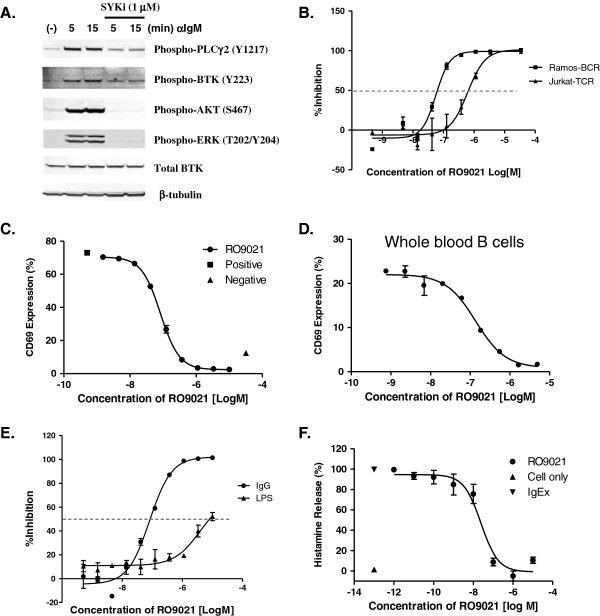Figure 2.
Inhibition of B-cell receptor and Fc Receptor pathways by RO9021. (A) RO9021 inhibited phosphorylation of PLCγ2(Y1217), BTK(Y223), AKT(S476) and ERK(p42/44) (T202/Y204) in anti-IgM stimulated Ramos cells. The levels of total Bruton’s tyrosine kinase (BTK) and β-tubulin were used as loading controls. (B) RO9021 suppressed anti-IgM mediated calcium flux in Ramos cells (Ramos-BCR, squares), but not anti-CD3-mediated calcium flux in Jurkat cells (Jurkat-TCR, triangles). Intracellular calcium concentrations were measured using a calcium-sensitive fluorescent dye and presented as calculated percentage inhibition. (C), (D) Inhibition of anti-IgM-induced CD69 expression in human peripheral blood mononuclear cells (PBMCs) (C) and whole blood (D). Data were in duplicate and are shown as mean ± standard deviation (SD). (E) RO9021 inhibited FcγR signaling (human IgG-coated beads, dots), but not toll-like receptor-4 (TLR4)-induced TNFα production (lipopolysaccharide (LPS), triangles) in human monocytes. Percentage of inhibition by compound presented. Data were in quadruplicate and are shown as mean ± SD. (F) Inhibition of histamine release in human mast cells induced by anti-4-hydroxy-3-nitrophenylacetyl hapten (NP) IgE and NP. Anti-NP IgE and NP cross-linking-induced a robust histamine release (cells alone, triangle; IgEx, inverted triangle). RO9021 attenuated IgE-NP-induced histamine release in a concentration-dependent manner (circle). Data were in triplicate and are shown as mean ± SD.

